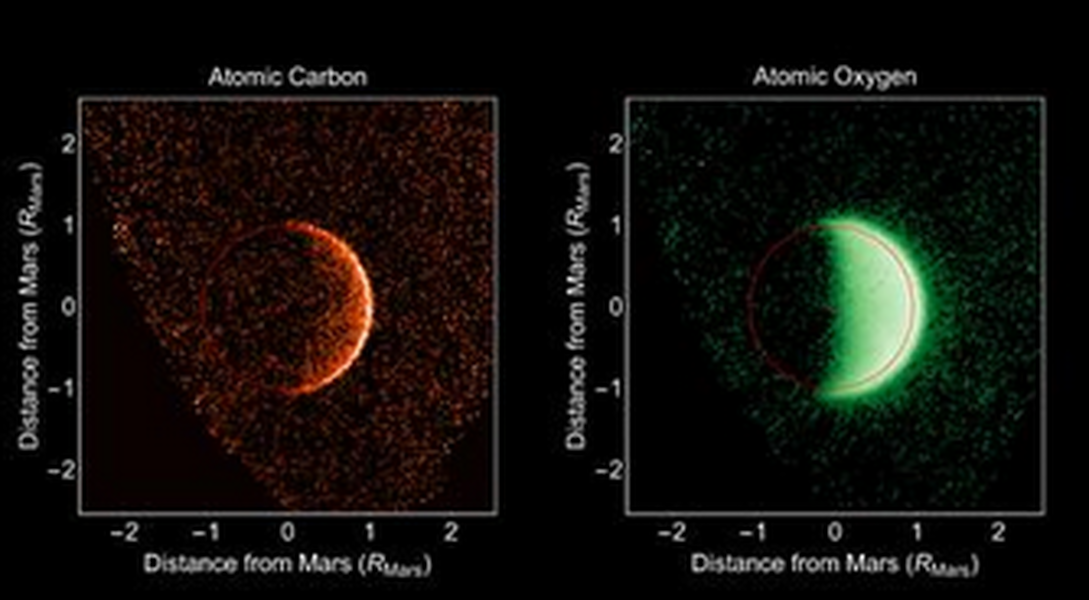NASA's MAVEN gives first look at Mars' atmosphere


NASA's MAVEN spacecraft has provided its first results from its Mars mission, and its findings have given scientists a fresh look at the Martian atmosphere.
MAVEN, whose primary investigator is based at the University of Colorado's Laboratory for Atmospheric and Space Physics, provided scientists with three views of Mars' atmosphere. The spacecraft was launched in November 2013 "to help solve the mystery of how the Red Planet lost most of its atmosphere," according to NASA.
The three new views of Mars' "escaping atmosphere" will help the MAVEN remote sensing team to better understand the processes of Mars' atmospheric loss by "observing all of the products of water and carbon dioxide breakdown," NASA reports. The results from the MAVEN spectograph have revealed a "storm of energetic solar particles" on Mars, the result of coronal mass ejections from the sun and a possible cause of atmospheric loss.
The Week
Escape your echo chamber. Get the facts behind the news, plus analysis from multiple perspectives.

Sign up for The Week's Free Newsletters
From our morning news briefing to a weekly Good News Newsletter, get the best of The Week delivered directly to your inbox.
From our morning news briefing to a weekly Good News Newsletter, get the best of The Week delivered directly to your inbox.
MAVEN has provided "unprecedented ultraviolet images" of the oxygen, hydrogen, and carbon of the Martian atmosphere. Using MAVEN's observations, the scientists were able to create a map of the Martian ozone beneath atmospheric coronas. The scientists will conduct two weeks of "instrument calibration and testing" before MAVEN begins its "primary science mission" in November.
A free daily email with the biggest news stories of the day – and the best features from TheWeek.com
Meghan DeMaria is a staff writer at TheWeek.com. She has previously worked for USA Today and Marie Claire.
-
 7 bars with comforting cocktails and great hospitality
7 bars with comforting cocktails and great hospitalitythe week recommends Winter is a fine time for going out and drinking up
-
 7 recipes that meet you wherever you are during winter
7 recipes that meet you wherever you are during winterthe week recommends Low-key January and decadent holiday eating are all accounted for
-
 Nine best TV shows of the year
Nine best TV shows of the yearThe Week Recommends From Adolescence to Amandaland
-
 Blue Origin launches Mars probes in NASA debut
Blue Origin launches Mars probes in NASA debutSpeed Read The New Glenn rocket is carrying small twin spacecraft toward Mars as part of NASA’s Escapade mission
-
 Dinosaurs were thriving before asteroid, study finds
Dinosaurs were thriving before asteroid, study findsSpeed Read The dinosaurs would not have gone extinct if not for the asteroid
-
 SpaceX breaks Starship losing streak in 10th test
SpaceX breaks Starship losing streak in 10th testspeed read The Starship rocket's test flight was largely successful, deploying eight dummy satellites during its hour in space
-
 Rabbits with 'horns' sighted across Colorado
Rabbits with 'horns' sighted across Coloradospeed read These creatures are infected with the 'mostly harmless' Shope papilloma virus
-
 Lithium shows promise in Alzheimer's study
Lithium shows promise in Alzheimer's studySpeed Read Potential new treatments could use small amounts of the common metal
-
 Scientists discover cause of massive sea star die-off
Scientists discover cause of massive sea star die-offSpeed Read A bacteria related to cholera has been found responsible for the deaths of more than 5 billion sea stars
-
 'Thriving' ecosystem found 30,000 feet undersea
'Thriving' ecosystem found 30,000 feet underseaSpeed Read Researchers discovered communities of creatures living in frigid, pitch-black waters under high pressure
-
 New York plans first nuclear plant in 36 years
New York plans first nuclear plant in 36 yearsSpeed Read The plant, to be constructed somewhere in upstate New York, will produce enough energy to power a million homes
